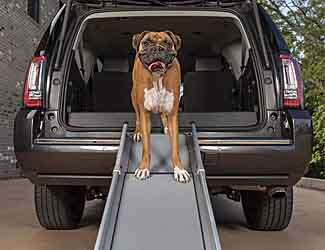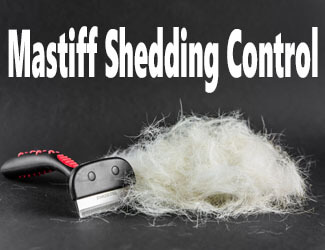How to Socialize a Mastiff
8 Easy And Helpful Tips
by Ken Alden
Mastiffs are a large and loyal breed that are wary of strangers which is why it's wise to learn how to socialize a Mastiff early on. Since they are alert around others, mastiffs need to be socialized to feel comfortable around new people, dogs, and in different environments.
How To Socialize A Mastiff
To socialize a mastiff puppy, you have to begin the process as soon as possible. Make sure to introduce them to various stimuli, make new introductions positive, and attend classes. To socialize an adult mastiff, use a muzzle, go on walks, introduce new people one at a time, and don’t get upset.
This article will provide you four helpful tips for socializing a mastiff as a puppy, and four tips for socializing a mastiff as an adult. Of course they work well on any Mastiff from Bullmastiffs to Cane Corsos to English Mastiffs. Read More Below...
Pro-tip: Ever try lifting a Mastiff? Their weight can hurt not only your back but their joints when they hop down from cars, sofas or even your bed. To protect your back and theirs check out the best Mastiff ramps on Amazon.com now.

Socializing a Mastiff Puppy
Socializing mastiffs while they are puppies is important for future success. Although your dog can be socialized as an adult, it’s easier to socialize dogs while still young. Socializing mastiffs during puppyhood often results in fewer problem behaviors in the future.
1. Begin Socialization As Soon as Possible
Your mastiff’s first months of life are incredibly important. Puppies learn the most during their first 3 to 16 weeks, so the experiences they have during this period will impact them for the rest of their lives.
During this crucial period, you’ll need to socialize your dog. Socialization is the process of exposing your puppy to as many things as possible. This process makes your dog feel less fearful and more confident in their environment.
A responsible breeder will begin the socialization process with your mastiff a few days after birth. The breeder will start by gently touching your puppy and will allow them to explore their environment. Once your puppy is handed over to you, you should start socializing them to their new surroundings as soon as possible.
By learning how to socialize a Mastiff to different animals and people in
their environment, you’ll make them feel less guarded and wary of others as an
adult.
2. Introduce Your Pup to Sights, Smells, and Noises
Your mastiff puppy is new to the world, so many things will be unfamiliar and strange. This is your opportunity to introduce them to as many people, animals, sights, smells, and noises as possible.
Try to introduce them to a wide variety of people, such as children, people with beards, people wearing sunglasses and individuals in wheelchairs. The more people they are exposed to as a puppy, the more comfortable they will feel around them as an adult.
Regarding other animals, introducing your mastiff to dogs that are different sizes and breeds is important. However, don’t stop there! Let your puppy see cats, horses, birds, and other types of animals accessible in your area.
When exposing your mastiff to different sounds, take them outside. Let them experience the sounds of children playing, cars going by, and more. You can play the radio or TV at home to get them used to different voices and noises.
Your puppy will naturally want to smell things, so let them. Give your mastiff the chance to explore and smell different plants, objects, and people.
If you’d like a full list of things you should
expose your puppy to, check out this comprehensive
socialization checklist.
Pro-tip: Mastiff anxiety, aggression, destructive chewing, jumping up, fearfulness, and other behaviors can be controlled with the right training program.
Here’s a great course that
addresses these issues along with many other dog training basics: Check it out now!
3. Make Their Experiences Positive
Every time you introduce your puppy to something new, you should try to make the experience as positive as possible.
Give your puppy a lot of social praise every time they interact with something or someone for the first time. Always praise your mastiff for any positive behaviors they exhibit. They are very sensitive dogs, so they learn quickly based on their owners’ emotions.
You can also provide your puppy with treats while they are interacting with something new.
Ask your vet for recommendations when choosing which treats to give your pup. You’ll likely need to break the treats into small pieces to make sure they are easy for your puppy to consume.
If you praise your mastiff and provide treats, they will begin to view the unfamiliar object, animal, or person they are interacting with as something positive and fun.
4. Attend Puppy Classes
Puppy classes are great for teaching your puppy some basic commands. They are also a helpful way to socialize your puppy with other people and dogs.
Trainers will ensure that your puppy is safe and is getting the best possible experience during these classes.
Talk to your vet before attending a puppy class to ensure that your mastiff has proper vaccinations.
Socializing an Adult Mastiff
If you got your mastiff as an adult and they need socialization training, have no fear. Although being socialized as a puppy is ideal, your mastiff can still learn how to interact with other people and animals at an older age. Follow these four tips recommended by Hill’s for the best results.
1. Use a Muzzle
Mastiffs are large dogs and can get easily frightened if they weren’t socialized as puppies. To protect other dogs and people, it may be a good idea for your dog to wear a muzzle in case they become aggressive.
Plus, having a muzzle on your mastiff will allow you to feel more comfortable when they interact with new stimuli. Muzzles can make your dog and the new dog they are interacting with feel calmer and more receptive to meeting each other. Other dog owners may also feel more comfortable allowing their dog to interact with your mastiff if they are wearing a muzzle.
Pro-tip: Mastiff's (and their owners) love dog crates…and for good reasons. Crates keep dogs from mischief while you're away, are perfect for house training, for traveling by car, and provide the dog a place to de-stress. Check out the best Mastiff crates on Amazon.com now.
2. Introduce New People and Dogs One at a Time
Adult dogs that were not socialized as puppies can quickly become overstimulated and frightened, leading to problem behaviors. To avoid this, introduce your mastiff to one human or dog at a time.
When you first start introducing your mastiff to new dogs, you should select a calm and friendly dog. This will help put your mastiff at ease.
When introducing your dog to new people, make
sure to give them some of your mastiff’s favorite toys and treats. This will
help them form a
positive association with the stranger. If
they become frightened, don’t push it. Just reintroduce the person at a later
point in time when they are calmer.
3. Take Your Mastiff for Regular Walks
Take your dog for frequent walks to expose them to new people, animals, sights, sounds, and smells. This will expose them to new things in a safe way that you can regulate. If your mastiff starts to act frightened, either distract them with a treat or toy or calmly redirect them away from the frightening situation. Praise your mastiff and give them treats when they are calm or interact positively with new stimuli.
Even though your mastiff is older, they can still learn that new things can be non-threatening and fun.
4. Don’t Get Worked Up...Relax!
Since your adult mastiff was never fully socialized, they will likely be “on-edge” during unfamiliar situations. If your mastiff becomes frightened during one of these instances, do not react. If you yell at them or provide them with a lot of attention, it will reinforce his behavior.
Instead, ignore your dog’s reaction and keep a
calm expression on your face. Mastiffs are very good at reading
body language and facial expressions,
so if you are calm in scary situations, they will learn to be calm.
How To Socialize A Mastiff...Final Thoughts
When socializing a mastiff, it is ideal to start the process as soon as possible. When you get your new mastiff puppy, you should begin socializing them to new dogs, people, and situations right away. Make sure to praise your puppy whenever they interact with something new and provide them with treats.
If you get your mastiff as an adult and not socialized, you’ll need to slowly and carefully introduce them to new things. It is recommended that you put them in a muzzle at first to make everyone feel more comfortable being around them. You can start socializing your adult mastiff by taking them on walks and introducing them to new people and dogs one at a time.
I hope this article helps you socialize your mastiff so they can feel confident and happy in any situation.

About the Author...
Ken Alden, a dedicated Mastiff owner for over eight years, is acclaimed for his expertise in care, grooming, and training. Read more About Me and my dog Shadow.
- Mastiff Guide Home ›
- Mastiff Dog ›
- How To Socialize A Mastiff









